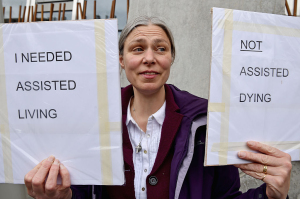Trump's School Transgender Policies: Common Sense and Legal

Contrary to almost all the news reporting on this story, the real question addressed by the new administration's guidance is not (at least not directly), "Which restrooms or locker rooms should students who identify as transgender use?"
Instead, it is something much simpler — "Who gets to decide?"
The answer that President Trump's administration has now given is also simple: "Not us. Not the federal government."
The two Obama administration documents that have now been rescinded — a 2016 "Dear Colleague" letter to every school district in the country, and a lesser-known "opinion letter" issued January 2015 — asserted a specific interpretation of a specific federal law.
"Title IX" is common shorthand for "Title IX of the Education Amendments of 1972" — a federal law which prohibited discrimination on the basis of "sex" in any school that receives federal funds (as all do).
The Obama administration argued that discrimination based on "sex" includes discrimination based on "gender identity;" and that failing to treat students in accord with their self-perceived "gender identity" (rather than their biological sex) in all school activities (including restroom and locker room assignments) constitutes such "discrimination."
This position is legally untenable. Title IX was enacted by Congress, and signed into law by President Nixon, in 1972. It strains credulity to suggest that the legislative intent of Congress — 45 years ago — was to authorize biological males to use female facilities, and vice versa. The logical conclusion is that "sex" in Title IX is a reference only to one's biological sex at birth.
If Congress wanted to expand the reach of Title IX to encompass "gender identity" as well as "sex," Congress could amend the law to do so. Until now, they have chosen not to. No president simply has the authority under our Constitution to effect such an expansion unilaterally. President Trump's decision to withdraw the Obama guidance should be welcomed by anyone who believes in limited government or in the rule of law — regardless of how they feel about transgender issues.
Making "gender identity" a protected category under non-discrimination laws or policies would raise concerns beyond the question of bathrooms and locker rooms. Will staff be punished for inadvertently referring to a transgender student by the wrong, non-preferred, pronoun? Will fellow students have their freedom of speech or religion infringed upon, by being punished for expressing the view that God created human beings male and female, or that biological sex is a more valid indicator of maleness or femaleness than subjective "gender identity?"
The issue of sex-separated facilities or programs is an important one. Even future Supreme Court Justice Ruth Bader Ginsburg, defending the proposed Equal Rights Amendment to the U.S. Constitution to prohibit sex discrimination under the law, wrote in the Washington Post in 1975 that "the equality principle" is compatible with having facilities separated on the basis of sex, declaring, "Separate places to disrobe, sleep, perform personal bodily functions are permitted, in some situations required, by regard for individual privacy."
Common sense, however, tells us that the reason we have separate facilities for men and women, boys and girls in the first place is not because their gender identities are different, but because their anatomy is different.
Court precedents on physical privacy have established that it is a right which includes the right not to expose one's nude or semi-nude body to someone of the opposite biological sex, and similarly not to be exposed involuntarily to the nude or semi-nude body of someone of the opposite biological sex. The Obama guidelines would have cast this privacy right to the winds, in favor of an unrestricted preference for gender identity over biological sex.
Many observers express concern about the needs of students who identify as transgender — as they should. But what about the concerns of Kaeley Triller Haver — a rape survivor who showered in her underwear because of the trauma she had endured? What about the female student in Illinois who now wears her gym clothes to school under her regular clothes — and then puts the regular clothes back on over the gym clothes, without showering — in order to avoid exposing herself to a biological male who was given permission to use the girls' locker room?
Providing single-user, gender-neutral restrooms or changing facilities is a reasonable accommodation that could protect everyone's concern for privacy and safety — yet it has been rejected as discriminatory by transgender activists and the Obama administration.
The Trump administration policy will open the door for such accommodations to ensure that the legitimate needs and concerns of all students are met. This is far preferable to a "one-size-fits-all," top-down solution imposed by the federal government.





























